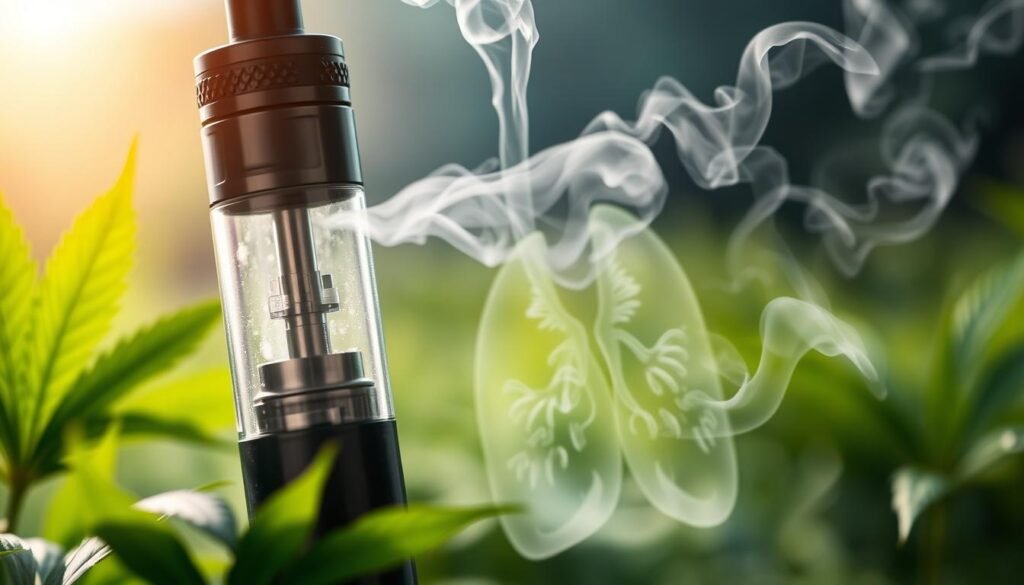It might be surprising, but research shows that marijuana smoke has harmful stuff like tar, ammonia, and even cyanide. With more states making marijuana legal, it’s super important to know about its health risks. This is especially true for lung cancer. While we all know smoking tobacco is bad for the lungs, how weed affects them is still up for debate. This article will look into how smoking pot might affect your lung health, including the risks and what experts are saying.
Key Takeaways
- Marijuana smoke contains many harmful substances, increasing potential lung cancer risks.
- Research indicates smoking marijuana may lead to changes in lung tissue associated with cancer growth.
- Smoking weed can cause chronic bronchitis and other respiratory problems.
- Secondhand marijuana smoke poses risks to non-smokers, especially vulnerable populations.
- Further research is crucial to understand the long-term effects of cannabis smoking on lung health.
Understanding Marijuana and Its Components
Marijuana has different active parts, mainly tetrahydrocannabinol (THC) and cannabidiol (CBD). THC causes the “high” feeling. Meanwhile, CBD has health benefits without making you feel euphoric. This makes CBD very interesting for its healing possibilities.
The health impacts of marijuana go beyond its ability to get you high. Studies show that cannabis smoke has harmful chemicals like ammonia and hydrogen cyanide. These can hurt your bronchial passages and lungs, which raises worries about lung problems. Even though cannabis smoke has things that can cause cancer, there’s no clear proof it leads to lung cancer. This is according to the National Institute of Drug Abuse (NIDA).
Knowing what makes up marijuana is key for any talks about its use. Being aware of what’s in cannabis shows its good and bad sides for health. For instance, smoking marijuana a lot can cause cough and phlegm, similar to what happens with tobacco. It’s crucial to see both the positive and negative effects of using marijuana.
The Process of Smoking Weed
Understanding how to smoke weed means looking at various ways to use cannabis. People often smoke using pipes, bongs, or joints. Each method affects the level of harmful substances inhaled.
Many people think holding smoke in your lungs longer makes cannabis effects stronger. Yet, this might increase the risk from harmful chemicals in the smoke.
The risks from smoking weed are not simple. Studies show cannabis smoke has more harmful chemicals than tobacco smoke. This could lead to serious health issues. Also, smoking cannabis results in more tar in the lungs because people inhale deeply. This can cause breathing problems, like coughing and wheezing.
When comparing marijuana to tobacco, the risks and methods vary. Tobacco smokers have a higher risk of lung cancer. However, it’s less clear how cannabis affects long-term health. Some studies on marijuana and lung cancer give mixed findings.
As cannabis use becomes more accepted for health and fun, it’s crucial to know how it’s used. More studies will help us understand the health effects of smoking weed.
https://www.youtube.com/watch?v=QDDnYcn-o8I
Can Weed Give You Lung Cancer?
The topic of marijuana and its effects is getting more attention lately. Can weed give you lung cancer? Many people are asking this as doctors study its effects on lung health. Although the evidence is mixed, it’s known that weed smoke has harmful substances like tar. These substances are also found in tobacco smoke. They make people worry about lung cancer from smoking pot.
Research on Cannabis and Lung Cancer Risks
Some research suggests that smoking weed a lot can change lung tissue. These changes hint at a risk of cancer later on. Smoke from cannabis can make the lungs’ airways thick and swollen. Studies also show harm to the lungs in people who smoke weed compared to those who don’t smoke at all. Weed smokers also have more mucus and trouble fighting infections. For people with diseases like HIV, smoking weed can make it easier to get sick. Studies highlight that smoking makes these problems worse.
Comparative Analysis with Tobacco Smoking
When we compare smoking weed and tobacco, the health risks are quite similar. Both types of smoke can harm the lungs badly. Smoking weed can cause chronic bronchitis, leading to coughing and wheezing. When weed is smoked with tobacco, the health risks go up. Telling the effects of each on health separately is hard. Research using chest scans shows more airway damage in those who only smoke weed than in those who only smoke tobacco. This fact pushes for more studies on the health effects of smoking pot.
Chemicals Found in Marijuana Smoke
Marijuana smoke carries harmful chemicals that can affect our health, especially regarding lung cancer. It contains benzene, tar, ammonia, and carbon monoxide. These substances are bad for our lungs. We need to look closely at how they impact us, compared to tobacco smoke.
Potential Carcinogens in Weed Smoke
Marijuana smoke has substances that may increase lung cancer risk. It has about 50 percent more benzopyrene and 75 percent more benzanthracene than tobacco. These marijuana carcinogens pose serious health risks. They can lead to chronic bronchitis and a higher chance of cancer over time.
Comparison of Toxins in Marijuana and Tobacco
A detailed study looks at the toxins in marijuana versus tobacco. Both have harmful toxins and cancer-causing agents. However, marijuana and cigarette smoke differ in toxin levels and types. Some data suggest long-term cannabis use may increase lung cancer risks.

Short-Term Effects of Smoking Marijuana
Smoking marijuana affects your body and mind right away. People often feel more relaxed and notice things more. They also feel like time is moving differently. It’s important to know about the short-term effects of weed smoking that come with these feelings.
Even though it can feel good, smoking weed can harm your health quickly. You might start coughing or have trouble breathing. The smoke has harmful chemicals in it. Tar and ammonia, found in the smoke, can hurt your lungs and make you feel bad.
It’s essential for weed users to understand these short-term effects. Knowing the health risks helps people make smart choices about using marijuana. As more people use it, knowing the good and bad effects helps them use it safely.
| Immediate Effects | Potential Risks |
|---|---|
| Relaxed feelings | Respiratory issues such as coughing |
| Heightened sensory perception | Bronchial irritation |
| Altered sense of time | Wheezing |
Long-Term Health Risks of Cannabis Smoking
Smoking cannabis long-term can harm your health more than just lung cancer risk. It can lead to chronic bronchitis and harm your immune system. This can deeply impact your health and happiness.
Chronic Bronchitis and Other Respiratory Issues
Many who smoke cannabis often can get chronic bronchitis. This condition causes ongoing cough and more mucus. Smoking can inflame and damage lung pathways. It’s similar to what happens with cigarette smoke. Thus, it’s vital for smokers to watch out for breathing problems.
Being aware of these issues is crucial. Chronic bronchitis can turn into even more serious health problems later on.
Impaired Immune Response from Weed Smoking
Smoking cannabis can also weaken your immune defenses. This makes you more likely to catch respiratory infections. This is especially true for those with existing health issues. This is because smoking can harm lung tissue. It reduces your body’s infection-fighting power.
Understanding these risks is important. Smokers need to know that cannabis can weaken their immune system over time.

Secondhand Marijuana Smoke and Its Implications
Just like tobacco smoke, secondhand marijuana smoke is harmful. It contains dangerous chemicals such as ammonia, cadmium, and lead. These can cause lung issues and respiratory infections. Nearly half of the children in one study had detectable levels of marijuana in their urine from secondhand smoke. This shows the negative effects of being around weed smoke, especially for kids and other vulnerable groups.
Being around weed smoke can cause anxiety and make your eyes burn or itch. People might cough or feel sick. A study showed that rats exposed to this smoke for just a minute had problems with blood vessels for a long time. This could mean bad news for our hearts. Even if a room has good air flow, THC from the smoke can still cause a person to fail a drug test after being in a smoky area.
Children and those with conditions like asthma should be careful around weed smoke. If there’s a cannabis user in the home, kids are more likely to have THC in their systems. Secondhand smoke from marijuana can also carry mold and pesticides. This makes the risks of the smoke even bigger.
| Health Effects | Details |
|---|---|
| Respiratory Issues | Lung irritation, exacerbation of asthma symptoms |
| Cognitive Effects | Anxiety, paranoia, issues with attention and memory in teenagers |
| Exposure Risks | Higher susceptibility in children and immunocompromised individuals |
| Toxic Chemicals | Ammonia, cadmium, chromium, lead, etc., linked to lung cancer |
| Behavioral Symptoms | Nausea, fatigue, headache, restlessness |
We need to learn more about how secondhand marijuana smoke affects us. This knowledge is key to keeping everyone safe and healthy. For more info, click here.
The Impact of Vaping Cannabis on Lung Health
Vaping cannabis is getting more popular, but it affects lung health. While thought to be safer than smoking, it brings its own risks. It’s vital to know how impacts of marijuana vaping affect health for users and doctors.
Dangers of Vaping Concentrates
Vaping cannabis concentrates poses real dangers. THC vape pens, for example, may have harmful chemicals, especially if they’re not regulated. E-cigarette or Vaping Use-Associated Lung Injury (EVALI) is a serious issue, often caused by additives like vitamin E acetate in THC products. This problem has sent many users to the hospital.
Other hazards include:
- Getting lipoid pneumonia from inhaling oily substances.
- The risk of having a lung collapse, which might need surgery.
- A higher chance of catching respiratory infections.
Comparison with Traditional Smoking Methods
Studies show marijuana smoke has many harmful substances, similar to tobacco. Vaping might lower some risks from smoke, but vaping CBD can still hurt the lungs. Research finds vaping causes more inflammation and stress in lungs than smoking does.
When we look at the effects, we see that:
| Effects | Vaping Cannabis | Traditional Smoking |
|---|---|---|
| Toxins and Carcinogens | Similar to tobacco; may contain unregulated additives | Has well-known carcinogens and toxins |
| Respiratory Symptoms | Linked to more wheezing, cough | Causes bronchitis and airway issues |
| Lung Injury Risk | Higher with concentrate use | Comes with long-term use |

More research is crucial to fully understand vaping’s long-term effects. As health risks become known, it’s important for users to be aware of the dangers of vaping.
Age and Demographic Influence on Lung Health Risks
The relationship between age and the effects of smoking marijuana is complex. Research indicates that young people often smoke more, increasing their risk of lung problems. Since their lungs are still developing, the impact of marijuana on them can be significant.
Older adults might also face significant risks, especially if they already have health issues. The dangers from cannabis use grow as people age. Understanding how age and existing health conditions mix with marijuana use is key. This combination can lead to serious health issues, highlighting the need for specific public health plans.
Demographics also influence how people use marijuana. Young folks tend to try different methods like smoking, vaping, or eating edibles. Each of these has distinct risks. On the other hand, older people may use marijuana for health reasons, possibly ignoring its effects on the lungs.
Knowing who uses cannabis helps us understand the unique health dangers linked to age. We need education and intervention plans designed for each age group. By addressing these detailed challenges, health campaigns can help people of all ages make better choices. This could lead to improved lung health for everyone.
| Age Group | Risk Factors | Health Implications |
|---|---|---|
| Under 25 | Heavy usage, developing lungs | Increased respiratory issues |
| 25-44 | Experimentation, higher usage | Potential COPD risk |
| 45 and up | Pre-existing conditions, lighter usage | Compounded health risks |
Pre-existing Conditions and Vulnerabilities
Pre-existing health conditions change how marijuana affects people. It’s vital for doctors and users to understand these risks. People with asthma or weak immune systems might find cannabis especially challenging.
Effects on Individuals with Asthma
Marijuana smoke can make asthma worse. It has irritants that may trigger asthma attacks, causing coughing and trouble breathing. People with asthma should look into other ways to use cannabis, like edibles or oils, to avoid these risks.
Risks for Those with Compromised Immune Systems
Individuals with weakened immune systems should be cautious. Cannabis smoke harms lung defenses, increasing the risk of infections. Knowing your health status and choosing safely is crucial.
| Health Condition | Potential Impact of Marijuana Use |
|---|---|
| Athma | Increased coughing, breathing difficulties, inflammation |
| Compromised Immune System | Higher risk of respiratory infections, weakened lung defenses |
The Need for Further Research
The link between marijuana use and lung cancer is still unclear. This shows we need more further research cannabis health to fill the gaps. It’s vital to know the long-term impact of different marijuana forms and how they’re consumed.
Some studies suggest that smoking weed might harm the lungs much like cigarettes do. It’s thought one joint might have as much bad stuff as 10-20 tobacco cigarettes. The effect of smoking weed on lung problems like emphysema and chronic bronchitis still needs more study.
There’s not enough direct evidence that links smoking weed to lung cancer. This keeps people arguing. Thinking about the components of weed and tobacco smoke raises questions about lung health over time. Since lung cancer can take years to show up, it’s hard to see the immediate effects.
Using marijuana in non-smoking ways, like edibles or tinctures, might reduce inhalation risks. But, to really understand the health effects of weed, we have to keep studying it closely. This research will help create better health rules and advice by closing the gaps in marijuana studies.
| Aspect | Marijuana | Tobacco |
|---|---|---|
| Carcinogen Content | Similar to 10-20 cigarettes | Varies by brand and type |
| Common Health Issues | Chronic bronchitis, emphysema | Lung cancer, COPD |
| Recommended Forms | Edibles, tinctures | N/A |
| Research Status | Need for further studies | Extensive historical data |
Evaluating Public Perception and Misconceptions
Over the years, how people view marijuana has changed a lot. But, many still get facts wrong about smoking it. These mistakes can lead to using it carelessly. They can also make it hard to talk about the health effects. A common false idea is thinking the longer you keep the smoke in, the stronger the high.
This belief might make people smoke in a harmful way. It also takes away from understanding the real health risks of using cannabis.
Understanding the Myths About Holding Smoke
Many believe holding in smoke makes the high stronger. But THC, which is what gets you high, is absorbed by your body fast. Holding your breath won’t really make your high better. It could, however, expose you to more bad chemicals from the smoke.
It’s important we talk about how to use cannabis safely. And we need to base our talks on facts, not myths.
Social Attitudes Towards Marijuana Use
Today, more people are okay with using marijuana. Even so, wrong ideas about it are still out there. Surveys show fewer teens think marijuana is harmful. This has led more of them to try it.
About 45 percent of U.S. teens have tried marijuana by the time they finish high school. With how people think about marijuana changing, we face challenges. It’s tough when society downplays the real health concerns of smoking cannabis.
Conclusion
The study of how cannabis smoking affects lung health is complex. Some research suggests there are risks like chronic bronchitis and more respiratory infections. Yet, cannabis smoke and tobacco smoke are quite different regarding cancer risk. The American Lung Association states that marijuana smoke has harmful toxins similar to tobacco. These toxins can irritate the lungs and cause problems.
Studies from Europe and New Zealand have looked at cannabis and the risk of lung cancer. Long-term, heavy use might increase this risk. But when the studies take tobacco use into account, cannabis doesn’t seem to significantly impact lung cancer rates. This area is complicated, pointing out the need for more research and public health efforts. It’s important to figure out the effects of cannabis smoking and the best ways to use it safely, like vaporization.
With more people using cannabis, it’s key to understand its effects on lung health. For in-depth information, visit this detailed guide on cannabis and lung. Raising awareness and educating on this topic can reduce risks from smoking cannabis. It also encourages safer habits in the community.